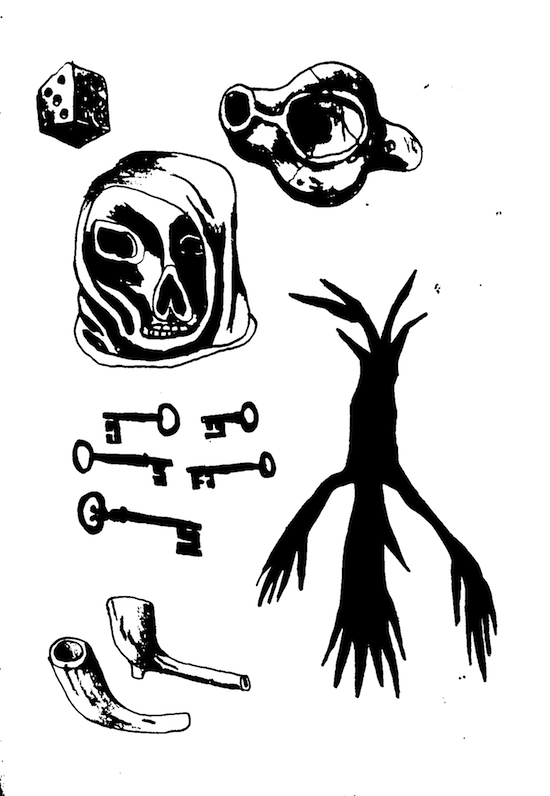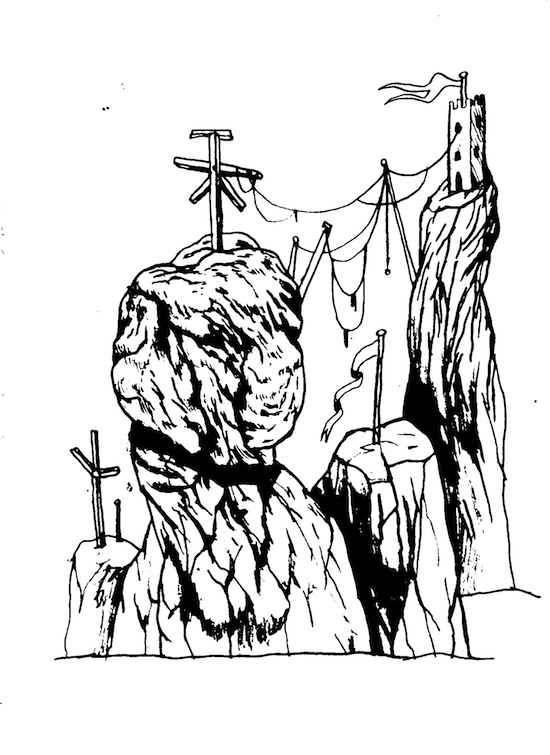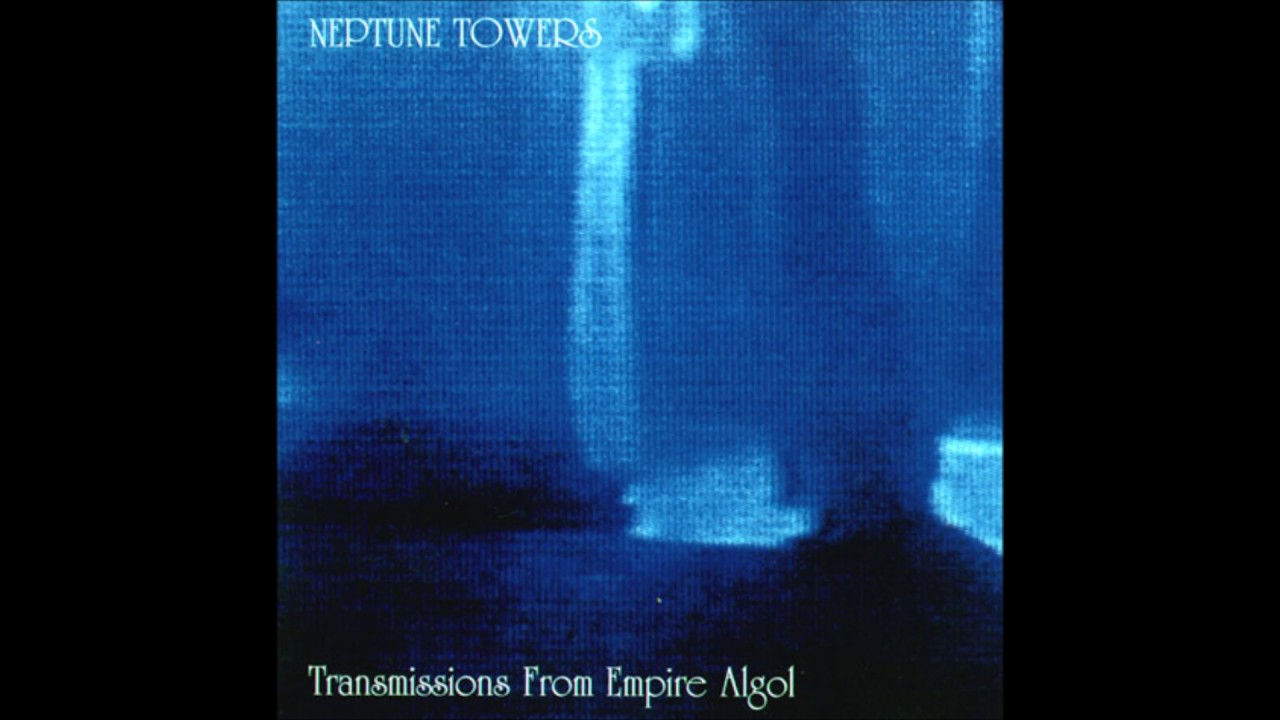Illustrations by Jakub Hrdlička
The heaths are unnaturally green this January afternoon. The path leads through the forest against the stream of a small creek, which we must cross at the right moment. After walking through the thicket for a while we see a small gorge, over which the Dršťka Castle towered in the 14th century. According to the nobility, the castle changed its name to Ronsperk, and later Losumberk. A musician releasing under the name of Mhor returns to this place, near the village of Skořice in West Bohemia.
Mhor is an artist in the minor genre of dungeon synth, evoking a medieval atmosphere that’s reminiscent of music that can be heard in fantasy video games. The Czech creators of dungeon synth can be counted on the fingers of one hand, but the worldwide internet community numbers in the thousands. Fans of the genre include metalheads and synth nerds, but also medievalists or fans of Dungeons & Dragons. The current interest in dungeon synth corresponds with the popularity of the fantasy genre in general, led by blockbuster television series such as Game Of Thrones and The Witcher.
Dungeon synth creates musical landscapes through which you may wander while telling fantasy stories. (It can also soundtrack your D&D night.) Although this niche has found a natural home on Bandcamp, the ruins of Dršťka Castle and stone circles somewhat better suit the genre. The castle has been abandoned since the 16th century, says the information sign, and you will find subtle traces of fortifications on one of the rocky peaks.
A sense of the untold defines dungeon synth – the music only lightly sketches the scenery, while the rest of the responsibility falls on the listener. "It is a pity to reach for some foreign fantasy when we live in a country with such a rich medieval footprint," says Mhor, a man in his thirties with an overgrown beard and the face of a hermit, as he pulls a firestriker to light a campfire in the woods. "A castle once stood here, and you can imagine all those stories."
The Black Speech of Mordor has long been adopted by the black metal bands of Norway, who often take the names of famous Orcs and have drawn darkness to their music first from fantasy, and then from neo-Nazism and murder. They often experimented with synthesizers and admired West German kosmische musik. This is especially true of the solo recordings of Mortiis from Emperor, whom dungeon synth fans refer to as their predecessor. "I never coined the dungeon synth phrase," said Mortiis in an interview with Cvlt Nation. "Although the record label I started in the 1990s to retain control of my music was, in fact, called Dark Dungeon Music. Many years later, it came to be known as one of the earliest [places you could find] dungeon synth albums."
The sound used to be called dark ambient – but finding exact boundaries between genres is lengthy, boring, and often nonsensical. Varg Vikernes came closest to the "real" dungeon synth when he recorded 1997’s Dauđi Baldrs and 1999’s Hliđskjálf under the name Burzum from prison, where he served 15 years for the murder of his colleague and friend Euronymus from Mayhem. The prison service allowed him only to use a keyboard and a simple computer recording set up, with this immediately becoming part of the legend. The dungeon tones sounded all the more ominous.
Mhor grew up on black metal, but he mostly enjoys subtle synthesizers over epic guitar parts. Dungeon synth draws its magic from the seemingly incompatible combination of the aura of the Middle Ages and software. "There’s this strange dissonance when folklore meets synthetic sounds," Mhor says. Perhaps this tension was best portrayed by another figure of the Norwegian black metal scene: Darkthrone’s Fenriz was, in the 1990s, obsessed with both space travel and albums by Tangerine Dream’s Klaus Schulze. Since then, he has produced electronic music alone. The tension between the mythology’s magical swords on the one hand, and the digital world on the other, was reflected directly in the title of his Transmissions From Empire Of Algol, released under the name Neptune Towers in 1995, and characterised by the futuristic beeping of synthesizers. Algol evokes some distant, ancient empire and is partly inspired by the star of the same name, also known as the Demon Star, that is central to H. P. Lovecraft’s short story ‘Behind The Wall of Sleep’. But there is also a more mundane context: ALGOL is the abbreviation of a programming language from the 1950s referring to “algorithmic language”.
Most dungeon synth resembles the soundtracks of old 8-bit fantasy video games, such as Lands of Lore. Indeed, on Mhor’s 2019 album Vichr V Haluzích, you can hear an echo of the music of the Diablo game series. "Nothing was revealed immediately,” he says. “When playing, you had to guess a lot. It was very DIY." It’s part of dungeon synth’s lo-fi, outsider aesthetic: music is often played on cheap keyboards and recorded with tape crackle. This amateurish feeling gives it an honest and refreshing allure.
Retro video games are also an important memory for Dunkelbot, another Czech dungeon synth producer. "I have long observed the genre as a passive fan who once admired dungeon games produced for Commodore 64. But instead of the high-quality graphics of The Bard’s Tale or Barbarian, Wizardry and Times Of Lore, I can mostly remember the music." The tracks from Dunkelbot’s debut EP Angerbach, named after the ruins of a German castle, would be at home on any vintage fantasy video game. "The essence of dungeon synth is always preserved, only the environment where the story takes place changes,” he says. “An RPG game, a stellar wandering, a goblin lurking in the bowels of catacombs, a kobold feasting in a pantry or guarding scaffolding in a desolate forest." Dunkelbot is experienced with synthesizers, also performing under the nickname Molly and as a member of the krautrock band Raw Deal. Going beyond pure dungeon synth, he often tries to evoke minimalism. "When I go to my sonic dungeon, it’s a hideout. It’s a deeply reclusive and often sad genre," Dunkelbot explains. He concludes: "Dungeon synth means you’re kind of a freak."
Streaming culture and YouTube has, over the past decade, weakened centralised pop culture. It has dispersed into microcultures that flourish in the most niche corners of internet. This has made it possible to evolve new genres, such as dungeon synth or vaporwave, directly on the forums where they were born. On Bandcamp, we find variations of the style with strange tags like "dungeon noise", "dino synth", "chiptune synth", "winter/forest synth" or "goblin synth". Another meeting point of the scene is the Dungeon Synth Archives YouTube channel, with 40,000 subscribers and new recordings posted every day. To orient yourself within these releases is often tricky, and artist names can make them sound like they’re born from a random fantasy glossary generator: Forlorn Kingdom, Ancient Boreal Forest, Hole Dweller, Nameless King, Old Sorcery, Haxan Dreams. Record covers picture deep forests, castles on rocks or snowy plains.

Everything is centred around loneliness. Dungeon synth means not only hours spent on computer games or synthesizers, but also long, solitary walks. As Archer Sanderson points out in the Weird Walk zine: "If there is one thing that good dungeon synth provides, it is escape. There are few worldly concerns here. Whereas their nefarious black metal cousins may dip into any number of (occasionally dubious) ideologies, the dungeoneers are solely preoccupied with generating atmosphere."
But that’s not entirely true. The dungeon synth scene is not free from the Nazis, and it has a dark side. One of the most famous producers, Old Tower, has the dubious side project entitled The Wampyric Specter, and the major dungeon-synth-themed Facebook group might question people who want to sign up to it about involvement in left-wing activities. Yet, Sanderson has uncovered something specific about the genre, and it connects dungeon synth to certain places in England, too: for listening, he recommends an old 14th-century fortification, stone circles, or a London cemetery with a Gothic chapel. This music takes the listener to a "pre-industrial" landscape that we know from fantasy books. There are many such places in Czechia.
For Garadrak, another local dungeon synth enthusiast, a walk to the ruins of Volfštejn Castle inspired the birth of his own project. In the “Wolf Mountains” of western Bohemia stands the remains of a wall and a circular tower on a small hill in the middle of the forest. "The place looks perfectly lonely and forgotten, especially at the very end of winter during a cloudy day, when only the cracking of the trees in the wind is heard,” says Garadrak. “As I walked around the ruins, I imagined how the ruler of the castle lived." He is also the only practitioner in Czechia connected to the global dungeon synth community – his records are posted on the Dungeon Synth Archive channel and he releases on the American label Akashic Envoy Records. Years ago, his Bohemian walking experience made him compose a song about a wandering knight, after which he named ‘A Questioning Knight’ in 2017. The character is an inhabitant of one of the fantasy worlds that the musician created a long time ago.
Garadrak is a scene favourite because he makes “pure” dungeon synth, building on simple 8-bit melodies or lute samples and leaving listeners with enough space for their imaginations. In composing, he simply acts as Dungeon Master, and all his albums carry storytelling as an essential element.
"Loremaster is about a mysterious sage who descends from the mountains to tell the stories to pilgrims,” he says. Last year’s Elegiac Winds is about “the breeze collecting the fragments of events around the worlds, and narrating them to whoever is willing to listen".
But if there is somebody who really anchors dungeon synth in the Czech landscape, it is Mhor. He also brings an unexpected ingredient to the genre: the phenomenon of tramp-wandering, which once served as an escape from communist reality in Czechoslovakia. "It seems to me that any genre music is actually a kind of escape – and it’s the same with tramping. You can wander under the ruins of a castle instead of [between] campsites," Mhor says, explaining the background of his album Vichr v haluzích, which was also picked up by Akashic Envoy Records. "When I can’t sleep, I play guitar by the fire. So I invented some motifs for my album during my wanderings," he says. The track ‘Kamarád Gháš’ (‘Friend Ghaas’) is a kind of joke. In the Black Speech of Mordor, ghaas means fire, and one of the songs by the founders of Czechoslovakian tramp music – the Ryvola brothers – features the lyric "our friend fire goes out". "It’s a direct link to that song," says Mhor, following folklore’s path in his recreating of that old tune.
After all, Vichr v haluzích could still be played by the fire on the guitar. He doesn’t compose typical 8-bit dungeon synth – you can hear mandolin and acoustic instruments in the foreground of his songs. Tracks like ‘V Kobkách Pod Horami’ (‘In The Dungeons Under The Mountains’) is reminiscent of the ominous murmur of witches from the soundtrack to Dario Argento’s 1997 film Suspiria, while elsewhere you can hear the recitation of eerie incantations, or mystical folk similar to Ulver’s 1996 record Kveldssanger.
His field recordings of the forest convey the connection with nature: the clatter of rocks, the crackling of the fire, the wind blowing and the treading of moss. "There are some off-road recordings, but not everything [is done this way]. I always dream of an atmosphere and terrain, but in the end, I record in the toilet," admits Mhor, who has slept several times at the castle ruins and its surrounding swamps in order to give his record a ghostly aura.

According to the legend, on a windy summer afternoon under the castle, fairies with wreaths appear, and at midnight speckled skeletons come out of the castle, while the rocks shake and shoot fireballs. "There must be a rumble in the dungeons like the echoes from the rocks somewhere nearby," says Mhor of his recording. But he always likes to ironically put down his ideas: "Sure it excites me, all this dungeon synth bullshit about magic swords, dragons and crypts. But most importantly, it should sound good."
Playfulness, the desire for storytelling, and perhaps the need to fill everyday reality with something supernatural, is what dungeon synth producers have in common. They share this passion with D&D players or Tolkien fanatics and language experts. "Dungeon synth is a getaway for me, but you’ll never run away completely,” says Mhor. “You re-create your reality, but differently than compared to dressing up as an Elf." I’m reminded of the words of Ursula K. Le Guin, who in her 1970s essay ‘Why Are Americans Afraid of Dragons?’ explains the power of legends, fairy tales, fantasy and "all these marginal insanities". Adults, she says, often dismiss fantasy stories as infantile because they fear the freedom. Le Guin advises parents to encourage imagination from an early age, otherwise, she thinks, children may be harmed: "I believe that maturity is not an outgrowing, but a growing up; that an adult is not a dead child, but a child who survived."
Dungeon synth is – with all the kobolds, fireballs and dragon caves – the outpost of those survivors, who have retained their childhoods’ free imagination. Although the genre is mostly based on nostalgia, its creators, in a totally rationalised and predictable world, also guard the promise of adventure somewhere else, in a never-never land whose laws cannot be fully explained.
This article was originally published in Czech on A2



